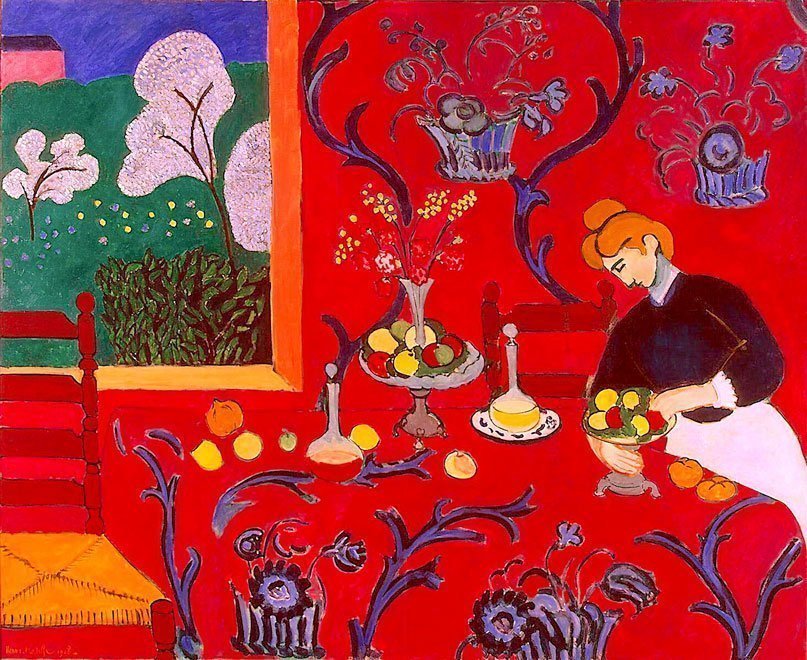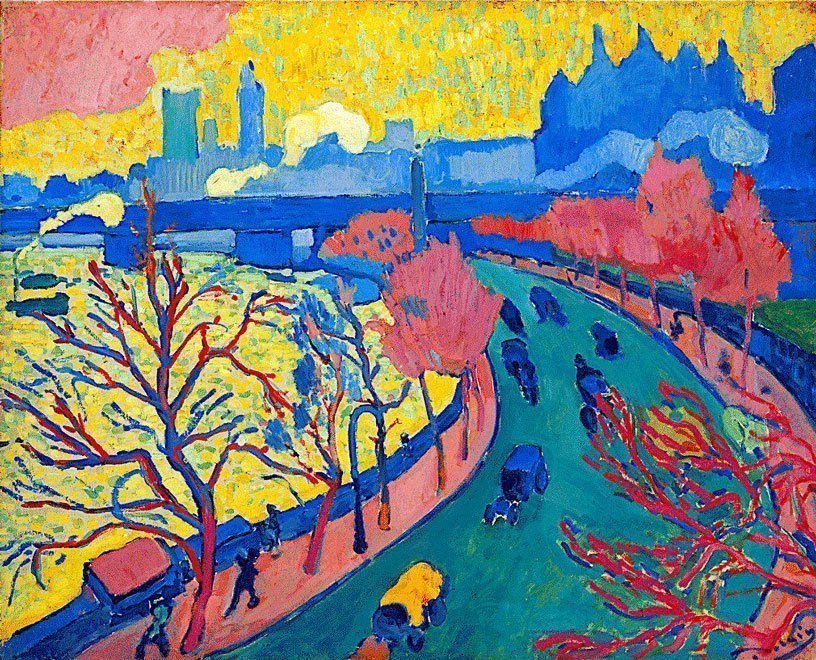Fauvism was the first of the avant-garde movements that flourished in France in the early years of the twentieth century.
Fauve painters were the first to break with impressionism and with the oldest traditional methods of perception.
His spontaneous, often subjective, response to nature was expressed in bold, unobtrusive brushstrokes and vibrant, high-intensity colours directly from the tube.
Painting in tubes had just been invented. Until then, they could only use pigments or solid paste.

Fauvism is born from the direct influence of Impressionism, a current that sought to capture reality as it looked, paying special attention to light.
The fauvist artists are indebted to the sources of the late 19th century, especially to the work of Vincent Van Gogh, a true magician of color.
Fauvism was a French pictorial movement of short duration, developed between 1904 and 1908 approximately. The artists, who love a rabid chromaticism, used pure and bright colours applied almost aggressively, directly from the paint tubes, to create a sense of explosion on the canvas.

Fauvism developed in France to become the first new artistic style of the twentieth century that influenced later styles.
In contrast to the dark and vaguely disturbing nature of the symbolic art of the end of the century or the bright impressionism of the beginning of the century, the Fauves produced bright cheerful landscapes and paintings of figures, characterised by vivid colours and distinctive brushstrokes.
In 1905, an exhibition organised by artists in response to the conservative policies of official exhibitions or shows in Paris was shown at the “Salon d’Automne”.
The contrast with traditional art was so surprising that it led the critic Louis Vauxcelles to call them “wild beasts”, and the name was born.
After contemplating the strident and aggressive color ranges of the paintings on display, he attributed the term “fauves” to them (in Spanish means wild animals).

The name assigned was originally a qualifying pejorative, as happened to other artistic movements of the twentieth century. The funny thing is that it was assumed by the public and subsequently introduced into the history of art without derogatory connotations.
The movement was built around Henri Matisse who was its maximum representative. Around him, other French artists participated or composed in the style of the movement. They highlights are Andre Derain, Albert Marquet and Kees Van Dongen. In 1906 George Braque and Raoul Dufy also joined.
A separate case, although many of his works also adopt Fauve color, is the Russian based in Paris, Marc Chagall.

Fauvism was not a consciously defined movement and lacked a manifesto. It was a mosaic of contributions where each painter undertook his work as a personal experience full of spontaneity and freshness. They were joined by the violent attitude with which they faced the conventions of the time, rejecting the established rational rules and methods.
They reacted against Impressionism and against the importance they had given to real light at the cost of colour loss.
The fauvists believed that through colours they could express feelings. This philosophy conditioned their way of painting. They were not looking for a naturalistic representation, but to enhance the value of colour by itself. Therefore, they rejected the soft palette of tones used by the Impressionists, in favor of almost violent colours to create a greater expressive emphasis.

They used direct and vigorous brushstroke, with thick touches, without mixtures, avoiding shading the colours. The figures are flat, linear, enclosed in thick contour lines. Their creations responded to an exercise in synthesization.
They sought the maximum emotional intensity combined with the maximum simplification of elements. That is why they renounced the classical perspective, chiaroscuro and modelling of volumes.
The light tends to disappear and with it, the depth. The subjects are portraits, still lives, interior characters and beautiful landscapes.
Another of its characteristics is the taste for the aesthetics of African statues and masks. The art of primitive peoples is not imitative, but it raises an obvious departure from naturalistic ways to tend to schématisations.
To talk about the origins or precedents of this style, we have to remember Van Gogh and Gauguin, since both fleeing from Impressionism, took a free and personal, impulsive and passionate execution. Both opted for intensely coloured works.
Henri Matisse

Considered the leader of the Fauvists, he was the only one who did not change his direction in his entire life. His passion was to express feelings through the use of color and form.
His first training was carried out within the academic tradition in the atelier of Gustave Moreau, being a fellow student of Albert Marquet and Georges Roualt.
He made numerous copies of the paintings of the old masters while studying contemporary art, especially that of the Impressionists, and later started his own experimentation.
His most fovist works are: “The Joy of Living”, “The Red Room” and “The Dance”.

Matisse’s true artistic liberation, referring to the use of color as the creator of spatial forms and planes, occurred under the influence of Van Gogh and Gauguin. He also adopted the Signac pointillist technique, but modified it by applying broader brushstrokes.
In his work “The Joy of Living” (1905) he summarises his initial learning of classical paintings, Gauguin, Japanese prints and Persian and Byzantine icons. It will be the key work of his career.
It is a scene fruit of his imagination, totally subjective. He used the theme of bathers and oriental odaliscas, transferring them to a western environment. He defined the spaces by means of wide areas of colours without shading, structured by means of the lines of the bodies, that direct the view of the spectator and mark the rhythm of the composition.

The construction with color and formal simplification dominated his paintings with great audacity and security. Matisse draws with color, which is what gives the painting an entity, being able to play the role of drawing, perspective and shadow of volumes. In his work there is joy and serenity. It is a kind, gentle art, a path into the depth of himself.
Matisse received international recognition during his life earning the approval of art critics and collectors.
One of his most important commissions were two paintings, “The music” and “The dance”, where volume and rhythm are harmoniously combined. He used only three colours to print movement to dancers who seem to float in the air at the rhythm of a cheerful rhythm.
Andre Derain

Most of the Fauvist production are country and urban characters, such as “Bridge in London” (1906) by André Derain.
They show pure colours, often applied on the canvas directly with the tube, irregular brushstrokes and carelessness for perspective or for realistic representation.
By 1908 Derain began experimenting with other styles. Cézanne’s influence leads him to a quieter color and greater control in his compositions.

In “Bathers” (1908) he tries to combine the innovations of the previous painters, such as Monet and Cézanne.
He was influenced by Cubism producing geometric works such as “The Old Bridge of Cagnes” and the Primitivism of African sculpture. His latest works, after 1912, will increasingly show the influence of diverse styles.

In summary, fauvism is characterised by the use of pure and strident, almost fluorescent colours.
Colour becomes an absolute protagonist to delimit, provide volume, relief and perspective to works with themes similar to the impressionists that precede them. Both paint landscapes, portraits and scenes of everyday life.
The difference with Impressionism is that the Fauvists transmit with their painting, a cry of optimism through colour.
Fauvist art sought to resume the natural state of man through a primitive aesthetic.
The artists of this movement did not care about the aspects of painting composition, but about their expressive qualities.
Their passion is the symbolic representation of emotions through colours, the more alive the better, capturing figures and shapes in vibrant compositions.

Fauvists depict trivial and joyful matters, without political or critical connotations.
This style of painting was constituted as an art of balance, purity and glorification of instincts and vital sensations. Artists capture their visual impressions on their fabrics.
Fauvism also influenced literature, represented by the book “Jazz”, by Henri Matisse, where his works as well as other authors and some articles.
The artistic current of Fauvism is characterised by the use of strong and bright colours such as red, green, yellow, blue and purple, used without relation to reality.
Through the use of colours in their pure state, painters simplify shapes, delimit and model volumes through a non-existent graduation of nuances of tones.
They also use long and spontaneous brushstrokes to delimit the planes and create depth sensations.
Another feature is that thick strokes give an appearance of disorder. This chaos is emphasised by a certain degree of deformation of objects and people, which often appear with grotesque expressions.
Fauvism was not an organised artistic trend, but it gathered and shared common characteristics in the paintings for a brief period, specifically with strong brushstrokes and an extremely vibrant colour.

The Fauvist movement has been compared to German Expressionism, for its projection of bright colours and spontaneous brushstrokes.
The French were more concerned with the chromatic aspects of the pictorial composition while the German expressionists were more involved in the psychological depth of their subjects.
The pictorial movement was short lived. By 1910, the artists of the group had diverged towards more individual interests. However, Fauvism remains significant, as it demonstrated the ability of modern art to evoke intense emotional reactions through a radical visual form.

